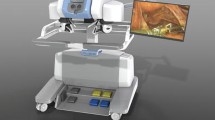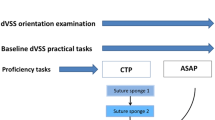Abstract
Virtual reality simulators are increasingly used to gain robotic surgical skills. This study compared use of the da Vinci Surgical Skills Simulator (dVSSS) to the standard da Vinci (SdV) robot for skills acquisition in a prospective randomized study. Residents from urology, gynecology, and general surgery programs performed three virtual reality tasks (thread the ring, ring rail, and tubes) on the dvSSS. Participants were then randomized to one of the two study groups (dVSSS and SdV). Each participant then practiced on either the dVSSS or the SdV (depending on randomization) for 30 min per week over a 4-week time period. The dVSSS arm was not permitted to practice ring rail (due to no similar practice scenario available for the SdV group). Following 4 weeks of practice, participants performed the same three virtual reality tasks and the results were recorded and compared to baseline. Overall and percent improvement were recorded for all participants from pre-test to post-test. Two-way ANOVA analyses were used to compare the dVSSS and SdV groups and three tasks. Initially, 30 participants were identified and enrolled in the study. Randomization resulted in 15 participants in each arm. During the course of the study, four participants were unable to complete all tasks and practice sessions and were, therefore, excluded. This resulted in a total of 26 participants (15 in the dVSSS group and 11 in the SdV group) who completed the study. Overall total improvement score was found to be 23.23 and 23.48 for the SdV and dVSSS groups, respectively (p = 0.9245). The percent improvement was 60 and 47 % for the SdV and dVSSS groups respectively, which was a statistically significant difference between the two groups and three tasks. Practicing on the standard da Vinci is comparable to practicing on the da Vinci simulator for acquiring robotic surgical skills. In spite of several potential advantages, the dVSSS arm performed no better than the SdV arm in the final assessment of participant scores. Our findings indicate that both the SdV and dVSSS can be beneficial to residents in improving their robotic surgery skills.
Similar content being viewed by others
References
Scott DJ, Bergen PC, Rege RV et al (2000) Laparoscopic training on bench models: better and more cost effective than operating room experience? J Am CollSurg 191:272–283
Fried GM, Feldman LS, Vassiliou MC et al (2004) Proving the value of simulation in laparoscopic surgery. Ann Surg 240:518–528
Korndorffer JR Jr, Dunne JB, Sierra R et al (2005) Simulator training for laparoscopic suturing using performance goals translates to the operating room. J Am CollSurg 201:23–29
Seymour NE, Gallagher AG, Roman SA et al (2002) Virtual reality training improves operating room performance: results of a randomized, double-blinded study. Ann Surg 236:458–464
Stelzer MK, Abdel MP, Sloan MP, Gould JC (2009) Dry lab practice leads to improved laparoscopic performance in the operating room. J Surg Res 154:163–166
Uchal M, Raftopoulos Y, Tjugum J, Bergamaschi R (2005) Validation of a six-task simulation model in minimally invasive surgery. Surg Endosc 19:109–116
Grantcharov TP, Kristiansen VB, Bendix J et al (2004) Randomized clinical trial of virtual reality simulation for laparoscopic skills training. Br J Surg 91:146–150
Albani JM, Lee DI (2007) Virtual reality-assisted robotic surgery simulation. J Endourol 21:285–287
Lucas SM, Giley DA, Joshi SS, Gardener TA, Sundaram CP (2011) Robotics training program: evaluation of the satisfaction and factors that influence success of skills training in a resident robotics curriculum. J Endourol 25:1669–1674
Lerner MA, Ayalew M, Peine WJ, Sundaram CP (2010) Does training on a virtual reality robotic simulator improve performance on the da Vinci surgical system? J Endourol 24:467–472
Hernandez JD, Bann SD, Munz Y, Moorthy K et al (2004) Qualitative and quantitative analysis of the learning curve of a simulated surgical task on the da Vinci system. Surg Endosc 18:372–378
Korets R (2011) Validating the use of the Mimic dV-trainer for robotic surgery skill acquisition among Urology Residents. Urology 78:1326–1330
Sutton C, McCloy R, Middlebrook A et al (1997) MIST VR. A laparoscopic surgery procedures trainer and evaluator. Stud Health Technol Inform 39:598–607
Cakmak H (2005) VS One, a virtual reality simulator for laparoscopic surgery. Min Invas Surg 14:134–144
Schijven M, Jakimowicz J (2003) Virtual reality surgical laparoscopic simulators. Surg Endosc 17:1943–1950
Thijssen A (2010) Schijven M Contemporary virtual reality laparoscopy simulators: Quicksand or solid ground for assessing surgical trainees? Am J Surg 199:529–541
Intuitive Surgical Web Site (2016) www.intuitivesurgical.com/products/products_faq.html#19
Acknowledgments
The authors would like to thank the residents of Charleston Area Medical Center that participated in this study, the O.R. Department at Charleston Area Medical Center Memorial Division, and staff at the CAMC Patient Simulation Center.
Author information
Authors and Affiliations
Corresponding author
Ethics declarations
Conflict of interest
Dr. Brown has no disclosures and has no conflict of interest. Dr. Mosley has no disclosures and has no conflict of interest. Dr Tierney has no disclosures and has no conflict of interest.
Rights and permissions
About this article
Cite this article
Brown, K., Mosley, N. & Tierney, J. Battle of the bots: a comparison of the standard da Vinci and the da Vinci Surgical Skills Simulator in surgical skills acquisition. J Robotic Surg 11, 159–162 (2017). https://doi.org/10.1007/s11701-016-0636-2
Received:
Accepted:
Published:
Issue Date:
DOI: https://doi.org/10.1007/s11701-016-0636-2




